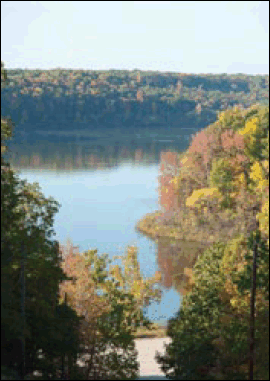Green Horizons
Volume 19, Number 1Winter 2015
Water quality is everyone’s responsibility but the Missouri DNR has a lead role
By Robert Stout | Mo. DNR
 |
Photo courtesy of MDNR |
Missouri abounds with natural diversity in abundance. Our varied landscapes range from the rolling farmlands in the north to the Ozark hills in the south to the Mississippi River bottoms in the east and the open prairies in the west. Our water resources are equally diverse with crystal clear spring-fed streams, man-made recreational lakes and the Mississippi and Missouri Rivers.
Gov. Nixon announced in November that he has designated 2015 as the Year of Water. We can celebrate the fact that our water and air are significantly cleaner today than they were 40 years ago. While the issues we face today are not as obvious as they used to be, there is still a great deal we need to do. Maintaining water quality relies in large part on the stewardship efforts of all Missourians. Agricultural and suburban-urban stormwater and wastewater disposal, mining, stormwater runoff, improper well construction or closure and on-site wastewater disposal practices can pose threats to our surface water and groundwater quality.
The Mo. Department of Natural Resources celebrated its 40th anniversary in 2014. The Omnibus State Reorganization Act of 1974 created the department, bringing together nearly 15 existing agencies that shared complementary missions to achieve common goals in environmental protection and cleanup, conservation and management of Missouri's natural, cultural and energy resources.
In the past 40 years: we've improved water quality by issuing and enforcing permits to control the quality and amount of wastewater that enters our waters; we've ensured the state's 2,738 public water systems provide safe drinking water to every resident and visitor to the state; we've helped communities build and maintain their water and wastewater infrastructure; we've provided financial assistance to address point and nonpoint source pollution to improve our state's water quality; and we've properly disposed of nearly 17 million scrap tires from Missouri's landscapes and waterways.
Every Missourian depends on good quality water for their quality of life. We depend on abundant clean water for drinking, agriculture and industrial purposes. We want clean, pristine rivers and lakes when we are swimming, canoeing, boating and playing in our waters during the recreational season.
Water pollution compromises the ability of our streams and lakes to provide us with quality drinking water, abundant fish stocks, irrigation, recreation and other vital services.
"Our Missouri Waters" is the department's forwardlooking effort to improve the water quality in every watershed in Missouri. The department understands the importance of collaboration and cooperation with the people who live and work in the watershed. So those are the people we are talking to throughout the state. We want to share what we know with them, listen to their ideas and help them to identify what needs to be done. Then together we can take action to work on our common priorities to protect, preserve and enhance the water resources in their watershed.
We have committed through "Our Missouri Waters" to establish and sustain the cooperative effort to meet with local partners to discuss and develop a watershed management plan. This plan will provide a clear path forward for groups to address sources of water pollution in their watershed. It will also serve as a guide to help meet the needs in areas of the state where sustainable groundwater supplies are limited or, where the projected need will exceed available resources.
Protecting our waters is necessary to ensure that future Missourians can have the same quality of life and opportunities we enjoy today. The DNR needs the help of citizens, landowners, communities, industries and local leaders for this effort to be successful. We can focus scientific, technical and financial resources to empower and support the people and communities in the watershed community. Continued public participation and building strong partnerships will be the key to our success. We can't do this alone-clean water is everyone's responsibility and we must all work together.